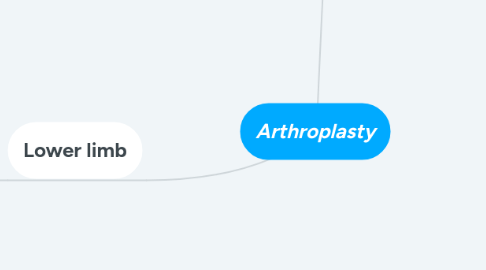
1. Upper limb
2. Lower limb
2.1. Hip
2.1.1. Bipolar hip
2.1.1.1. Fractures - elderly
2.1.1.2. No acetabulum replacement
2.1.1.2.1. shorter operation time
2.1.1.2.2. less blood loss
2.1.1.2.3. lower dislocation
2.1.1.2.4. lower embolism risk
2.1.1.2.5. lower cost
2.1.1.3. Lower friction PE (polyethylene) - ball & acetabulum
2.1.1.3.1. to prevent wear and pain
2.1.1.4. f.e. tapered 'exeter hip'
2.1.1.4.1. implants gets pushed into the bone during load which gives it a long survival time
2.1.2. Birmingham hip - resurfacing
2.1.2.1. Bone sparing
2.1.2.1.1. Original leg lengt
2.1.2.1.2. revision reserve
2.1.2.2. Large head 'natural'
2.1.2.2.1. low dislocation risk (0,3%)
2.1.2.2.2. large ROM
2.1.2.2.3. more 'natural motion'
2.1.2.3. Bearing surface metal on metal Co Cr
2.1.2.3.1. no PE wear particles
2.1.2.3.2. increased blood level metal ions
2.1.3. Surgical approach
2.1.3.1. Anterior
2.1.3.1.1. to place implant, hip is dislocated by exorotation
2.1.3.1.2. NO leg crossing!
2.1.3.2. Posterior
2.1.3.2.1. isn't used as much
2.1.3.2.2. Dislocated by rotating the leg: no natural movement, but don't let patients cross legs
2.1.3.3. Lateral
2.1.3.3.1. same as anterior, most of the time because you can't cross trough muscles
2.1.3.4. Scar tissue
2.1.3.4.1. Needs 6 weeks to heal
2.1.3.4.2. After 6w: shoud have force back, chance of dislocation decrease
2.1.4. Consolidation osteotomy (PSOS)
2.1.4.1. at least 6w non-weight bearing
2.1.5. Risks (1%)
2.1.5.1. Infection (glycocalix)
2.1.5.2. Loosening
2.1.5.3. Persisting pain
2.1.5.4. Mortality (embolism)
2.1.5.5. Instability (luxation)
2.1.5.6. Material failure
2.1.5.7. Fracture
2.1.6. Survival rates
2.1.6.1. 50-95% after 30y
2.1.7. Hip (des)artrodesis
2.1.7.1. surgical immobilization of a joint by fusion of the bones
2.1.7.2. Risks
2.1.7.2.1. Dislocation
2.1.7.2.2. Infection
2.1.7.2.3. Loosening
2.1.7.2.4. Pain
2.1.7.3. Feasability?
2.1.8. Take home message
2.1.8.1. artificial joint
2.1.8.1.1. It'll never be the same joint as it was once before
2.1.8.2. Patient can use it
2.1.8.2.1. Do NOT manipulate
2.1.8.3. Soft tissue envelope is weak
2.1.8.4. Risk of dislocation
2.1.8.5. Active functional rehabilitation
2.1.8.5.1. NOT passive/manipulation
2.1.8.6. Communication with the surgeon!
2.1.8.6.1. Weight bearing policy
2.1.8.6.2. Dislocation risk
2.2. Knee
2.2.1. Alignement
2.2.1.1. Mechanic - anatomic axis
2.2.1.2. Recurvatum
2.2.1.3. Rotation
2.2.1.4. Hip/ankle
2.2.1.5. PF alignement - Q angle
2.2.2. Isolated lesions
2.2.2.1. Trauma
2.2.2.2. OCD = osteochondritis dissecans
2.2.2.3. Young patient
2.2.3. Surgical repair
2.2.3.1. Debridement
2.2.3.2. Ice-picking
2.2.3.3. Cartilage transplantation
2.2.3.4. Chondrocyte culture
2.2.4. Degenerative
2.2.4.1. Unicompartimental
2.2.4.2. Varus - valgus
2.2.5. Gonarthritis
2.2.5.1. Uni-bi-tricompartimental
2.2.5.2. Knee arthroplasty
2.2.6. Knee arthroplasty
2.2.6.1. Approach
2.2.6.1.1. Tissue sparing
2.2.6.1.2. Tendon/liganent lesions
2.2.6.1.3. Osteotomy
2.2.6.1.4. Fracture
2.2.7. Survival rate
2.2.7.1. TKA
2.2.7.1.1. 90% 10y
2.2.7.1.2. 70% 20y
2.2.7.2. Revision survival
2.2.7.2.1. 85% 10y
2.2.8. Take home message
2.2.8.1. TKA rehab = soft tissue
2.2.8.2. Long period: 1y!
2.2.8.3. Active rehab preferable
2.2.8.3.1. Manipulations within pain limits
2.2.8.4. Soft tissue envelop is key
2.2.8.4.1. Fibrosis
2.2.8.4.2. Redness
2.2.8.4.3. Swelling
2.2.8.4.4. Above is normal
2.2.8.5. Active functional rehab
2.2.8.5.1. Limited passive/manipulation!
2.2.8.6. Regain flexion-extension postures
2.2.8.7. Communication with the surgeon
2.2.8.7.1. Weight bearing policy
2.2.8.7.2. Instability risks
2.3. Ankle and foot
2.3.1. Ankle arthritis
2.3.1.1. Tibiotalar
2.3.1.1.1. Arthroscopy
2.3.1.1.2. Artrodesis: handicap
2.3.1.1.3. Arthroplasty implant
2.3.1.2. Subtalar: triple artrodesis
2.3.1.2.1. Calcaneum - talus - naviculare - cuboideum
2.3.1.2.2. Arthritis/deformity (correction)
2.3.1.2.3. Loss eversion/inversion
2.3.1.2.4. Compromised before surgery
2.3.1.2.5. Intact flexion/extension
2.3.2. Postoperative ankle arthroplasty
2.3.2.1. Weight bearing within POP
2.3.2.2. Risk instability/loosening
2.3.2.3. After 6w, active extenion/flexion rehab
2.3.3. Small joints
2.3.3.1. More frequent athrodesis/resection arthroplasty
2.3.3.2. Swanson implant
2.3.3.2.1. used as implant in the big toe
2.3.3.2.2. These approaches are impractical and the long term survival isn’t known.
2.4. Conclusion
2.4.1. Arthroplasty design - option and indications
2.4.1.1. Available anatomy
2.4.1.2. Desirable biomechanics and kinematics
2.4.1.3. Motion - stability - survival... and NO pain
2.4.2. Technique variety - impact on rehab
2.4.2.1. Resurfacing
2.4.2.2. Constraint - linkage
2.4.2.3. Cementing
2.4.2.4. Surgical approach
2.4.2.5. Ligamentous/bony reconstruction
2.4.3. Remember: it's an artificial joint!
2.4.4. Key to succes: knowledge and communication
2.4.5. talk to patient! What are the risks, what is the impact on rehab! Communicate with surgeon!

